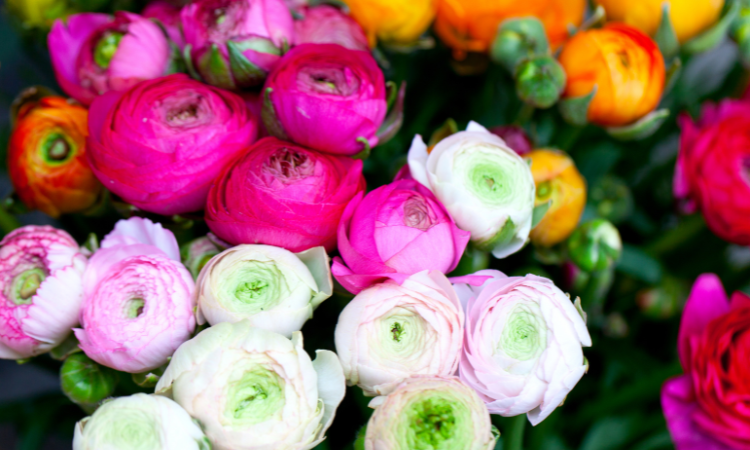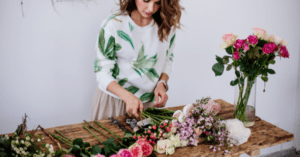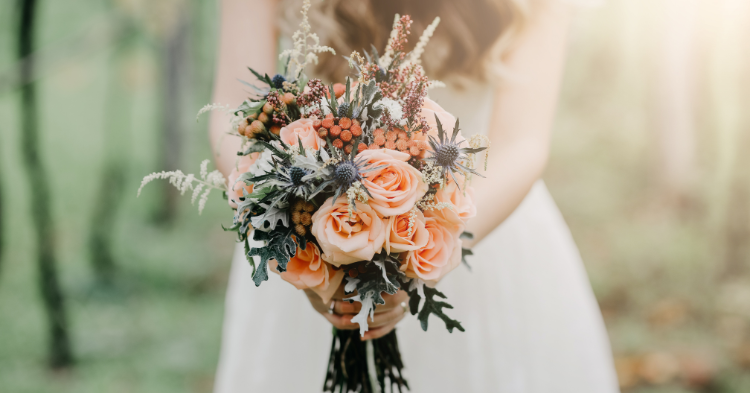If you’re looking for tips on how to grow ranunculus and take care of it, we are here to help! Growing ranunculus for floral design not only saves florists money but also brings the floral designer joy. Ranunculus flowers have intricate layers of delicate petals and vibrant hues. They have long captivated the hearts of flower enthusiasts and florists alike. Their allure lies not only in their exquisite beauty but also in their versatility as floral design elements. Ranuculus elevates the design in floral designs such as bridal bouquets, centerpieces, boutonniers, and other event designs.
This comprehensive guide will delve into the art of growing ranunculus for floral design while exploring everything from planting corms to nurturing healthy plants and harvesting the blooms.
Understanding Ranunculus:
Description of ranunculus flowers
Ranunculus flowers, often referred to as the “buttercup family,” encompass a diverse group of species known for their captivating blooms and wide array of colors. These flowers are characterized by their multiple layers of delicate, paper-thin petals that form intricate rosettes, thus creating a mesmerizing effect reminiscent of peonies or roses. Not only they are available in a myriad of colors ranging from soft pastels to vibrant jewel tones, but also in varieties. Ranunculus blooms offer endless possibilities for floral designers.
One of the distinguishing features of ranunculus is its varied forms and sizes, from compact to densely packed blooms. Additionally, ranunculus blooms can range in size from as small as a few inches in diameter to over three inches across, allowing for versatile use in floral arrangements of all scales.
When it comes to growing ranunculus for floral design, understanding the varieties and colors available is essential for selecting the right blooms. Choosing the right esthetics for your design will dictate the colors you will choose to grow. Whether you prefer the classic elegance of white and cream-colored blooms, the romantic allure of blush and pastel hues, or the bold statement of vibrant oranges, yellows, and reds, there is a ranunculus variety to complement any design palette.
Beyond their aesthetic appeal, it’s important to familiarize yourself with the specific growing conditions and preferences of ranunculus plants.
Ranunculus thrive in cool, temperate climates and prefer well-drained soil with plenty of organic matter; however, they will rot easily with extra moisture.
They are also sensitive to high humidity and wet conditions, so proper ventilation and soil drainage are crucial for their health and vigor.
In essence, understanding ranunculus is about appreciating its beauty, diversity, and unique growing requirements. By gaining insight into the different varieties, colors, and cultivation practices associated with these enchanting flowers, you can embark on a journey of growing and designing with ranunculus that is as rewarding as it is fulfilling.
Getting Started on How to Grow Ranunculus
Before diving into the cultivation of ranunculus for floral design, it’s essential to lay the groundwork for success by carefully preparing and planning your growing endeavors.
A. Choosing Ranunculus Corms:
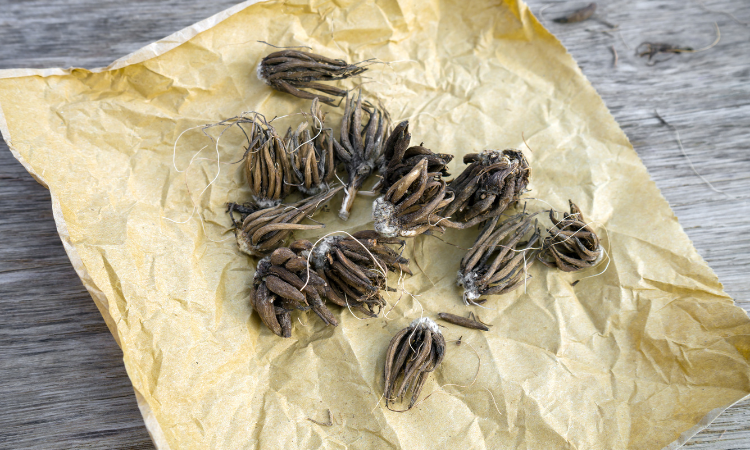
Selecting high-quality ranunculus corms is the first step towards a successful growing season. When purchasing corms, look for plump, firm bulbs free from signs of mold or damage. Opt for reputable suppliers or nurseries that specialize in flower bulbs to ensure the best possible quality. Consider the variety and colors you wish to grow, as ranunculus corms come in a variety of options, including single and double-flowered varieties, as well as an array of captivating hues.
B. Timing Ranunculus Planting Based on Location and Climate:
The timing of planting ranunculus corms varies depending on your location and local climate conditions. Fall planting is often recommended in regions with mild winters and cool, temperate springs. This allows the corms to establish roots and undergo the necessary cold period to promote robust growth and flowering in the spring. Conversely, in colder climates where frost is a concern, it’s best to wait until late winter or early spring to plant ranunculus indoors or in protected environments.
C. Preparing the Planting Site For Transplanting or Direct Sowing Ranunculus :
Preparing the planting site is crucial for providing optimal growing conditions for ranunculus. Choose a location that receives ample sunlight, as ranunculus thrive in full sun or partial shade. Ensure that the soil is well-drained and amended with organic matter, such as compost or aged manure, to improve fertility and soil structure. Prior to planting, loosen the soil to a depth of 6-8 inches and remove any weeds or debris that may compete with the ranunculus for nutrients and moisture. Consider incorporating a balanced fertilizer or slow-release fertilizer into the soil to provide essential nutrients for healthy growth and development.
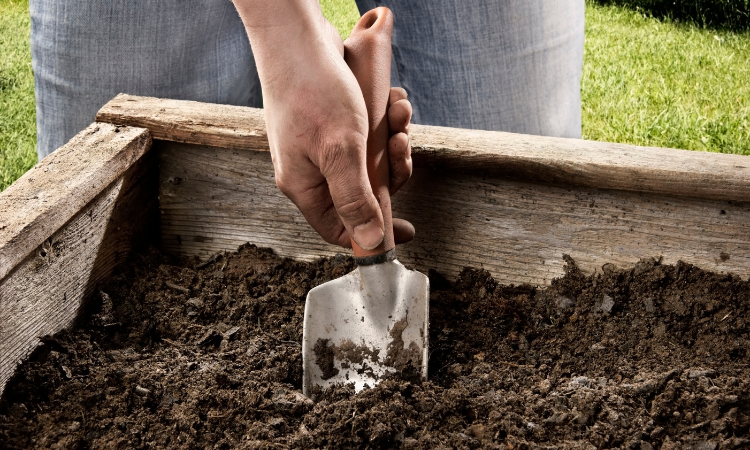
By taking these initial steps to select high-quality corms, plan the timing of planting, and prepare the planting site, you’ll set the stage for a successful growing season and ensure the best possible results when cultivating ranunculus for floral design.
Planting Ranunculus
Once you’ve selected the right corms and prepared the planting site, it’s time to embark on the exciting process of planting ranunculus. Whether you choose to grow them outdoors or indoors, proper planting techniques are essential for ensuring healthy root development and robust growth.
A. Outdoor Cultivation: When planting ranunculus outdoors, particularly in regions with mild winters, fall is the ideal time to get started. Follow these steps for successful outdoor cultivation:

- Selecting a Planting Location:
Choose a well-drained area with ample sunlight, as ranunculus thrives in full sun to partial shade. Additionally, if your soil is heavy or poorly drained, consider planting them in raised beds or containers.
- Preparing the Soil:
Prior to planting, prepare the soil by loosening it to a depth of 6-8 inches and incorporating organic matter, such as compost or aged manure, to improve fertility and soil structure. Remove any weeds or debris that may inhibit growth.
- Planting Depth and Spacing:
Plant ranunculus corms 2-3 inches deep with the “fingers” or tuberous roots facing downwards. Space the corms 6-8 inches apart for proper root development and air circulation between plants.
- Mulching and Watering:
After planting, apply a layer of mulch, such as straw or shredded bark, to conserve moisture and suppress weed growth. Water the newly planted corms thoroughly to settle the soil and provide initial hydration.
- Protecting from Frost:
In regions where frost is a concern, consider covering the planted area with a layer of frost cloth or floating row cover to protect the emerging shoots from cold temperatures.
Indoor Cultivation:
For indoor cultivation of ranunculus, late winter or early spring is the ideal time to plant corms to ensure a strong start before transplanting outdoors. Follow these steps for successful indoor cultivation:
- Choosing Containers:
Select containers with adequate drainage holes and fill them with a well-draining potting mix formulated for bulbs or flowers.

- Planting Depth and Spacing:
Plant ranunculus corms 2-3 inches deep in containers, ensuring that the “fingers” or tuberous roots face downwards. Space the corms 6-8 inches apart for proper root development.

- Watering and Care:
After planting, water the containers thoroughly to moisten the soil and provide initial hydration to the corms. Place the containers in a sunny indoor location, such as a bright windowsill or under grow lights, to promote healthy growth.

- Transitioning Outdoors:
Once the threat of frost has passed and outdoor temperatures are consistently above freezing, gradually acclimate the potted ranunculus to outdoor conditions by placing them in a sheltered location for a few hours each day. After a week or two, transplant them into the garden or larger containers, ensuring they receive adequate sunlight and water as they grow.
Following these planting guidelines for outdoor and indoor cultivation set the stage for healthy root development and robust growth, paving the way for a bountiful harvest of beautiful ranunculus blooms for floral design.
Growing Conditions for Ranunculus
Creating optimal growing conditions is essential for nurturing healthy and vigorous ranunculus plants that will produce abundant blooms for floral design. From temperature requirements to soil conditions and maintenance practices, here’s what you need to know to ensure your ranunculus thrives:
A. Temperature Requirements and Dormancy Period:
- Cool Temperatures:
Ranunculus thrive in cool, temperate climates and prefer temperatures between 50 to 65 degrees Fahrenheit (10 to 18 degrees Celsius) during the growing season.
- Dormancy Period:
Ranunculus enter a dormant phase when temperatures exceed 80 degrees Fahrenheit (27 degrees Celsius). During dormancy, growth slows, and the plant conserves energy until cooler temperatures return.
B. Soil Requirements and Drainage To Ensure Ranunculus Growth:
- Well-Drained Soil:
Ranunculus prefer well-drained soil with good aeration to prevent waterlogging, which can lead to root rot. Consider using sandy or loamy soils amended with organic matter to provide the ideal growing medium.
- pH Levels:
Aim for a slightly acidic to neutral soil pH between 6.0 to 7.0 for optimal nutrient uptake and plant health.
C. Watering and Humidity Control:
- Moderate Watering:
Provide regular, moderate watering to keep the soil consistently moist but not waterlogged. Avoid overwatering, as excessive moisture can lead to rot and fungal diseases.
- Humidity Levels:
Proper air circulation can help reduce humidity around the plants since Ranunculus prefers moderate humidity levels and may be susceptible to fungal diseases in high humidity conditions.
D. Fertilization and Nutrients:
- Balanced Fertilization:
Apply a balanced fertilizer, such as a 10-10-10 or 5-10-10 formula, at planting time and again during the growing season to provide essential nutrients for healthy growth and blooming.
- Organic Amendments:
Incorporate organic amendments, such as compost or aged manure, into the soil before planting to improve soil fertility and structure.
E. Sunlight and Shelter:
- Full Sun to Partial Shade:
Provide ranunculus with at least 6 to 8 hours of direct sunlight daily for optimal growth and flowering. In hotter climates, afternoon shade can help protect the plants from scorching sun and heat stress.
- Protection from Harsh Weather:
During extreme weather conditions, such as heavy rain or strong winds, provide shelter or support to prevent damage to the plants and blooms.
F. Pest and Disease Management:
- Monitoring:
Regularly inspect plants for signs of pests, such as aphids or thrips, and diseases, such as powdery mildew or botrytis.
- Integrated Pest Management (IPM):
Employ cultural practices, such as proper sanitation and crop rotation, as well as natural predators and organic pesticides, to manage pests and diseases effectively while minimizing environmental impact.
By carefully managing growing conditions and providing the necessary care and attention, you can create an environment that fosters healthy ranunculus plants with robust growth and abundant blooms, perfect for creating stunning floral designs.
Care and Maintenance of Ranunculus:
Proper care and maintenance are crucial for ensuring the health, vitality, and abundant blooming of ranunculus plants. From monitoring growth to pest management and grooming practices, here’s a comprehensive guide to caring for your ranunculus:
A. Monitoring Plant Growth and Development:
- Regular Inspection:
Conduct frequent inspections of your ranunculus plants to monitor their growth, development, and overall health.
- Observing Signs of Stress:
Watch for signs of stress, such as wilting, yellowing leaves, or stunted growth, which may indicate inadequate watering, nutrient deficiency, or pest infestation.
- Tracking Flowering Progress:
Keep track of flowering progress to anticipate bloom times and plan for harvest and floral arrangements accordingly.
B. Watering and Soil Moisture Management:
- Consistent Moisture:
Maintain consistent soil moisture by watering the plants thoroughly whenever the top inch of soil feels dry to the touch.
- Avoiding Overwatering: A
void overwatering, as excessive moisture can lead to root rot and fungal diseases. Ensure proper drainage to prevent waterlogging.
Mulching: Apply a layer of organic mulch, such as straw or shredded bark, around the base of the plants to help retain soil moisture, suppress weed growth, and regulate soil temperature.
C. Fertilization and Nutrient Management:
- Balanced Fertilization:
Apply a balanced fertilizer, such as a 10-10-10 or 5-10-10 formula, every 4-6 weeks during the growing season to provide essential nutrients for healthy growth and flowering.
- Avoiding Excess Nitrogen:
Avoid excessive nitrogen fertilization, as it can promote lush foliage growth. However, it will be at the expense of flower production. Opt for a fertilizer with a higher phosphorus content to encourage blooming.
D. Pest and Disease Management:
- Early Detection:
Monitor plants regularly for signs of pests, such as aphids, thrips, or snails, and diseases like powdery mildew or botrytis.
- Integrated Pest Management (IPM):
Implement IPM strategies, including cultural controls, such as handpicking pests, biological controls, such as introducing beneficial insects, and least-toxic chemical controls, if necessary.
- Practicing Good Sanitation:
Remove and dispose of any affected plant parts, such as diseased leaves or spent blooms, to prevent the spread of pests and diseases.
E. Grooming and Maintenance:
- Deadheading:
Regularly remove spent blooms by deadheading. Deadheading not only keeps the pest away but also encourages continuous ranunculus blooming. It prevents the plants from expending energy on seed production.
- Pruning:
Trim back any yellowing or damaged foliage to maintain plant health and appearance. Cut stems for floral arrangements at a 45-degree angle to facilitate water uptake.
- Supporting Tall Stems:
Provide support, such as bamboo stakes or flower rings, for tall stems to prevent them from bending or breaking under the weight of blooms.
F. Protecting from Adverse Conditions:
- Extreme Temperatures:
Cover plants with frost cloth or provide shade during the hottest part of the day to protect them from extreme temperatures, such as frost or heat waves.
- Strong Winds:
Stake tall plants or use windbreaks to protect them from damage caused by strong winds or heavy rain.
By implementing these care and maintenance practices, you can ensure the health and vitality of your ranunculus plants, maximizing their blooming potential and creating a bountiful harvest of exquisite flowers for your floral designs.
How and When to Harvest Ranunculus For Floral Design
Harvesting ranunculus blooms at the peak of perfection is essential for preserving their beauty and maximizing their vase life in floral arrangements. Timing and technique are key factors in ensuring a successful harvest:
A. Determining When to Harvest:
- Observing Bloom Development:
Monitor the progress of ranunculus blooms as they develop from tight buds to fully open flowers. Harvesting at the right stage of maturity ensures optimal freshness and longevity.
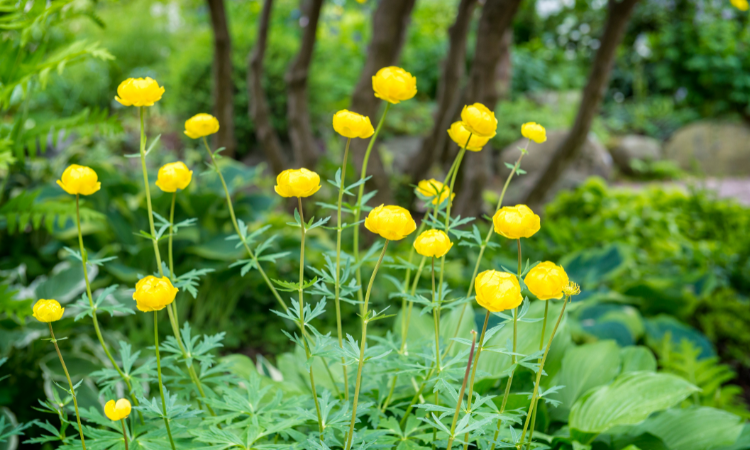
- Color and Petal Formation:
Look for blooms with vibrant coloration and fully formed petals that have opened to reveal the intricate layers characteristic of ranunculus flowers. Avoid harvesting blooms that are still tightly closed or showing signs of wilting or discoloration.
B. Techniques for Cutting and Handling Blooms:
- Selecting Tools:
Use clean, sharp floral shears or scissors to cut ranunculus stems, as dull or dirty tools can crush the stems and impede water uptake.
- Cutting at an Angle:
Cut stems at a 45-degree angle above a leaf node or lateral shoot to facilitate water absorption and prevent stem rot.
- Trimming Foliage:
Remove any excess foliage from the lower portion of the stems to prevent leaves from sitting in water, which can lead to bacterial growth and shorten vase life.
- Placing in Water Immediately:
Immediately after cutting, place harvested ranunculus stems in a bucket or vase filled with clean, lukewarm water to hydrate the flowers and prevent wilting.
C. Storage and Preservation Tips:
- Cool Storage:
Store-harvested ranunculus blooms in a cool, shaded location away from direct sunlight and heat sources to prolong their freshness. A cool basement or refrigerator set at 34 to 40 degrees Fahrenheit (1 to 4 degrees Celsius) is ideal for short-term storage.
- Hydration:
Keep ranunculus stems hydrated by regularly changing the water in their vases and recutting them every few days to promote water uptake.
- Avoiding Ethylene Exposure:
Keep ranunculus flowers away from sources of ethylene gas, such as ripening fruits, as exposure to ethylene can accelerate wilting and shorten vase life.
D. Incorporating Blooms Into Floral Designs:
- Design Considerations:
When designing floral arrangements, consider ranunculus blooms’ color, size, and shape. Pair them with complementary flowers and foliage to create visually appealing compositions.
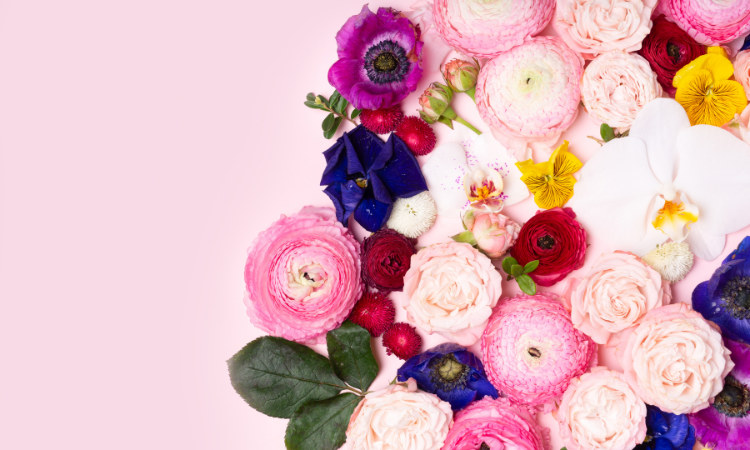
- Placement and Arrangement:
Experiment with different sizes, types, colors, and placements of the ranunculus in floral arrangements. Using arrangement techniques such as clustering blooms together for a focal point or scattering them throughout the arrangement, you can create the mood for the event the receipt requested.
- Vase Selection:
Choosing vases or containers that adequately support ranunculus stems and allow proper water uptake to keep the flowers hydrated and fresh is also important.


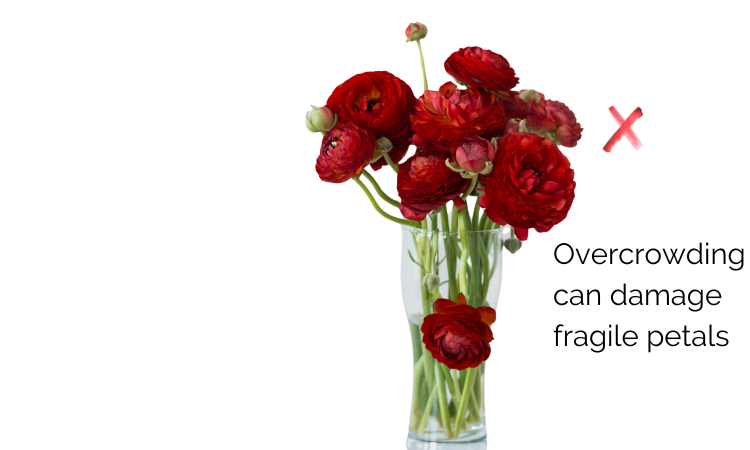
By following these harvesting and handling techniques, you can ensure that your ranunculus blooms remain vibrant, fresh, and beautiful for use in stunning floral designs that showcase their elegance and charm.
Conclusion
In conclusion, growing ranunculus for floral design enriches your garden with vibrant and exquisite blooms and empowers you as a floral designer to craft arrangements with a personal touch.
A diverse palette of ranunculus flowers allows limitless creativity, whether crafting bouquets for special occasions or enhancing everyday spaces. Nurturing these delicate blooms from corm to captivating bloom is a reward to a well-tended garden.
The practical benefits of cost-saving and choosing the freshest blooms for your floral design is a direct result of the time and care needed to grow ranunculus.
By embracing the tips and techniques outlined in this guide, you are well on your way to creating a flourishing ranunculus garden, which will bring beauty and joy into your life and those who experience your floral designs.
Get some free resources here for your floral business!

